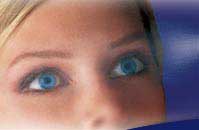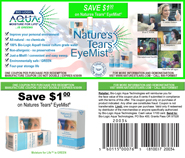
FOR IMMEDIATE RELEASE - April 5, 2012
Rogue Media
541-474-0950
Defining Dry Eyes:
Doctors Agree that Dry Eyes Involve Water Loss in the
Tear Film's Aqueous Layer
Physicians Look for a Series of Symptoms for Dry Eyes, Not an Exact Cause or Condition, Says Bio-Logic Aqua Research Founder Sharon Kleyne
Hear the Sharon Kleyne Hour Power of Water on World Talk Radio, Voice America, Green Talk Network and Apple iTunes
The causes and symptoms of dry eyes are so complex and variable that doctors have not agreed on a precise clinical definition of the syndrome. Dry eyes are the most frequently cited reason for visiting an eye doctor and so common that ophthalmologists find it difficult to draw a precise line between normal eyes and abnormal eyes with dry eye disease. (Mathers, 2005).
That was the conclusion of eye health advocate Sharon Kleyne, host of the Sharon Kleyne Hour Power of Water syndicated radio show and founder of Bio-Logic Aqua Research. In a recent interview, Mrs. Kleyne discussed the latest attempts to define "dry eyes," "dry eye syndrome" and "dry eye disease." According to Mrs. Kleyne, the only agreement is that dry eyes involve a loss of water in the tear film's "aqueous layer," due either to excessive evaporation or to poor tear production.
The three-layered tear film covering the eye's exposed portions is 99% water and extremely complex. The overlying "lipid layer" helps prevent water evaporation from the middle "aqueous (water) layer," while the lower "mucin layer" adheres the tear film to the eye.
Dry eyes are experienced by nearly everyone, says Mrs. Kleyne. Tear film dehydration (water loss) begins at the moment of birth, when you first open your eyes, and eyes require constant hydration throughout life. Because we are all unique, no two individuals are affected in exactly the same way by eye dehydration. Doctors agree that maintaining a healthy, fully hydrated tear film is becoming an increasing challenge for everyone.
According to Ula Jurkunas, MD, corneal stem cell researcher at Harvard University, "To function well, the cornea (clear part of the eye) must be well hydrated by the tear film. Hydration is also essential to successful corneal stem cell transplants" (Jurkunas, 2011).
Sharon Kleyne notes that, no physiologic variable correlates exactly with dry eye symptoms, although most measurable variables correlate to some degree. Instead, she explains, physicians look for a series of symptoms. The presence of one or more symptom could indicate a dry eye condition (Korb, 2000).
The most common dry eye symptoms include eye irritation, a feeling of dryness in the eyes; itching, burning and grainy or scratchy eyes; increased eye allergies, and blurred vision (especially late in the day). Symptoms such as fatigue, headache, muscle aches and an elevated stress level may not even directly involve the eyes (Mathers, 2005).
This symptom-based definition works reasonably well, according to Mrs. Kleyne. The degree and duration of symptoms are critical since a large percentage of the adult population complains of at least mild dry eye symptoms at any given time. This includes 50% of adult females and a significant percentage of computer users and contact lens patients (Mathers, 2005).
In addition to symptoms, most (but not all) dry eye patients have at least one physiologic parameter outside the range of normal. Typically, tear production has decreased, tear film volume is low, tear film evaporation is high, and/or tear film osmolarity is elevated (Mathers, 2004). In addition, tears produced in dry eyes contain elevated levels of substances (metalloproteases and other proteinaceous compounds) that increase surface inflammation (Barton, 1995).
Sources:
Barton, K, et al, Cytokines and tear function in ocular surface disease, Advances in Experimental Medicine and Biology, 1995
Jurkunas, U, "Corneal Reconstruction Using Stem Cells," Sharon Kleyne Hour, 2011
Korb, DR, "Survey of preferred tests for diagnosis of the tear film and dry eye," Cornea, 2000
Mathers, W, et al, Model for ocular tear film function, Cornea, 2004,
Mathers, W, Tear Film and Treatment of Dry Eye Disease, © 2005 RxSchools.com.
© 2012 Bio-Logic Aqua Research (133)









